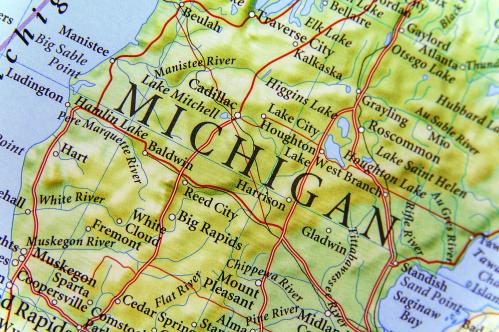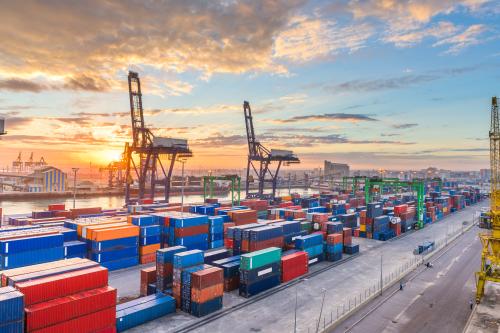President Trump’s unanticipated announcement of steel and aluminum tariffs has sent markets reeling, and stoked trade war fears. The president appears motivated in part to deliver on his promise to voters in the industrial Midwest, where many responded positively to his anti-trade rhetoric and pledge to dismantle what he called the NAFTA “disaster.”
But Trump’s proposed tariffs, which many see as his latest negotiating tactic to make Mexico and Canada accept his demands on NAFTA, are unlikely to help these Midwestern voters and their communities. The early consensus is that the tariffs would cost many more jobs than they will keep or create. As Economic Outlook Group chief economist Bernard Baumohl put it, “More workers in the U.S. make products that are made from steel, than make steel itself.”
The Midwest depends on NAFTA-enabled trade
Exports contribute significantly to the U.S. economy, today representing 12.3 percent of U.S. GDP. And the Rust Belt is at the center of this export economy, generating 26 percent of export-derived GDP (Figure 1). As prior Brookings analysis shows, “Trump Country,” particularly the communities of the Rust Belt, has been more affected by trade-related dislocations but also relies more on exports for jobs than other parts of the country.
At stake in the NAFTA talks are giant export markets for Heartland producers in Canada and Mexico. These nations are leading export markets for the 11 Midwestern states, which together account for 48 percent of all U.S. exports to Canada, and 21 percent of all U.S. exports to Mexico.

These totals include export-reliant firms and workers in three Midwestern states crucial to Trump’s margin of victory in the Electoral College. The share of Michigan’s exports to Mexico ranks third-highest in the country. Canada is the leading importer of Wisconsin goods. And Pennsylvania is the top state for exports of transportation equipment and confections to our North American neighbors.
Naturally, American auto, manufacturing, and agricultural executives and workers in those companies are nervous about an escalating trade war that could cut off these markets. A Michigan Big Three auto executive whose job is to accurately project global sales and profits told me, “We are bracing for whatever changes are made [in NAFTA]. It will hurt our ability to compete globally. But it will cost [Big Three rival] more.”
An interdependent production platform
The classic image of trade as one country “selling” something to another doesn’t accurately describe the economic reality of trade in the Midwest. Our jobs and incomes are tied up in highly interdependent, cross-border supply and production chains that go into making food, manufactured goods, and increasingly services.
As my Brookings colleague Joe Parilla noted last spring, more than half of North American trade occurs in intermediate goods—materials or components that companies import and integrate into the production of a final good. Nowhere is this more evident than in steel and aluminum markets, where Trump is proposing to fire his opening protectionist salvo. As reported in the New York Times, a Heritage Foundation analysis of Commerce Department data finds that U.S. mills and smelters that supply aluminum and steel raw materials today employ fewer than 200,000 people, while the U.S. companies that buy those inputs for making everything from cars, to beer cans, to chicken coops employ more than 6.5 million workers.
NAFTA critically facilitates this highly interdependent production system. The treaty originated as the U.S.-Canada “Auto Pact” to make it easier, more efficient, and cheaper to build cars across international boundaries. As Ana Campoy of Quartz magazine details, “NAFTA has transformed Mexico, the U.S., and Canada into a single manufacturing region, and cutting off suppliers through trade restrictions could make American producers less competitive.” Disrupting these supply chains with new tariffs or increased domestic content requirements in NAFTA for products like autos threatens to destabilize our highly productive continental manufacturing platform.
Grease the wheels of commerce, don’t throw sand in them
Our Midwest executives famously say, we don’t so much “trade” as we make things together, particularly in the tightly wound Great Lakes economy. An auto part may cross the U.S.-Canada border seven or more times as it is built up to a finished product. Wheat or corn may cross an international border to be processed, packaged, and returned as crackers, oil, or Cheetos. That is why the single largest trading location by value on earth is the bridge and tunnel crossing between Detroit and Windsor, Ontario, where well over $100 billion in goods crosses the international border annually.
The Midwest has a complicated history with trade. But the present and future of its key industries relies on maintaining its vital position in an integrated North American economy. By weakening NAFTA and imposing new tariffs on critical imports, President Trump would threaten the well-being of the very workers and communities that supported him most.
Lucas Arbulu contributed to this post.






Commentary
Why the Rust Belt economy will suffer in a trade war
March 6, 2018